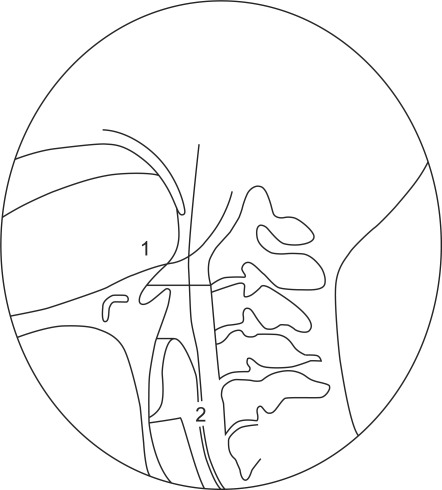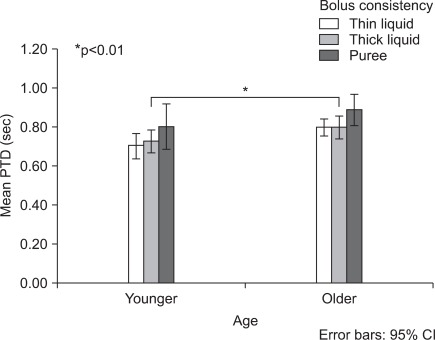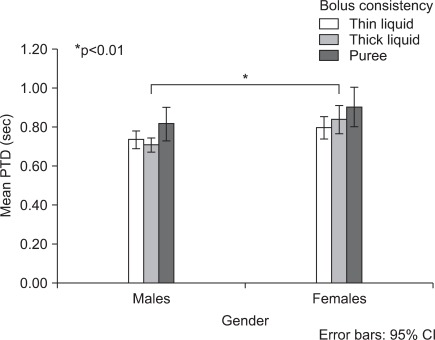Ann Rehabil Med.
2012 Apr;36(2):220-225. 10.5535/arm.2012.36.2.220.
The Effects of Bolus Consistency in Pharyngeal Transit Duration during Normal Swallowing
- Affiliations
-
- 1Graduate Course of Clinical Speech Language Pathology, Chonbuk National University, Jeonju 560-754, Korea.
- 2Communication Sciences and Disorders, Ohio University, Ohio 45701, USA. kimy2@ohio.edu
- 3Department of Physical Medicine and Rehabilitation, Chonbuk National University Medical School, Jeonju 560-754, Korea.
- KMID: 2266760
- DOI: http://doi.org/10.5535/arm.2012.36.2.220
Abstract
OBJECTIVE
To examine the effects of age, gender and bolus consistency in normal populations using the temporal measurement of Pharyngeal Transit Duration (PTD), which reflects the duration of bolus flow from the ramus of the mandible to the upper esophageal sphincter. METHOD: 40 normal and healthy subjects had Videofluoroscopic Swallowing Examinations (VFSEs) of 5 ml thin and nectar thick liquids, and puree consistencies. A slow motion and frame by frame analysis was performed. Three-way analysis of variance (ANOVA) was performed to examine the main effect and interactions, and paired t-tests for the three consistency comparisons.
RESULTS
Older subjects had a significantly longer PTD than younger subjects (p<0.01). In addition, men had significantly shorter PTDs than women (p<0.01). Puree showed a significantly longer PTD than the other two consistencies, regardless of age and gender (p<0.05).
CONCLUSION
PTD is an indicative of motor weakness in pharyngeal swallowing secondary to aging. In addition, the results supported the assumption that there is a functional difference in pharyngeal swallowing between men and women. It is expected that the results of this study will be used for further investigation of patients with dysphagia.
Keyword
Figure
Reference
-
1. Langmore SE, Terpenning MS, Schork A, Chen Y, Murray JT, Lopatin D, Loesche WJ. Predictors of aspiration pneumonia: how important is dysphagia? Dysphagia. 1998; 13:69–81. PMID: 9513300.
Article2. McHorney CA, Bricker DE, Kramer AE, Rosenbek JC, Robbins J, Chignell KA, Logemann JA, Clarke C. The SWAL-QOL outcomes tool fordysphagia in adults: I. Conceptual foundation and item Development. Dysphagia. 2000; 15:115–121. PMID: 10839823.3. Logemann JA. Evaluation and Treatment of Swallowing Disorders. 1998. 2nd ed. Austin: Pro-Ed;p. 3–5.4. Logemann JA, Pauloski BR, Rademaker AW, Colangelo LA, Kahrilas PJ, Smith CH. Temporal and biomechanical characteristics of swallow in younger and older men. J Speech Lang Hear Res. 2000; 43:1264–1274. PMID: 11063246.5. Logemann JA, Pauloski BR, Rademaker AW, Kahrilas PJ. Oropharyngeal in younger and older women: videofluoroscopic analysis. J Speech Lang Hear Res. 2002; 45:434–445. PMID: 12068997.6. Robbins J, Hamilton JW, Lof GL, Kempster GB. Oropharyngeal swallowing in normal adults of different ages. Gastroenterology. 1992; 103:823–829. PMID: 1499933.
Article7. Groher ME. The detection of aspiration and videofluoroscopy. Dysphagia. 1994; 9:147–148. PMID: 8082321.
Article8. Kim Y, McCullough GH, Asp CW. Temporal measurements of pharyngeal in normal populations. Dysphagia. 2005; 20:290–296. PMID: 16633874.9. Kim Y, McCullough GH. Stage transition duration in patients poststroke. Dysphagia. 2007; 22:299–305. PMID: 17610013.
Article10. Power ML, Hamdy S, Singh S, Tyrrell PJ, Turnbull I, Thompson DG. Deglutitive laryngeal closure in stroke patients. J Neurol Neurosurg Psychiatry. 2007; 78:141–146. PMID: 17012336.
Article11. Hamlet SL, Muz J, Patterson R, Jones L. Pharyngeal transit time: assessment with videofluoroscopic and scintigraphic techniques. Dysphagia. 1989; 4:4–7. PMID: 2640176.
Article12. Seikel JA, King DW, Drumright DG. Anatomy and Physiology for Speech. Language and Hearing. 2005. 3rd ed. New York: Thomson Delmar Learning;p. 197–200.13. Borgström PS, Ekberg O. Speed of peristalsis in pharyngeal constrictor musculature: correlation to age. Dysphagia. 1998; 2:140–144.
Article14. Stierwalt JA, Youmans SR. Tongue measures in individuals with normal and swallowing. Am J Speech Lang Pathol. 2007; 16:148–156. PMID: 17456893.
- Full Text Links
- Actions
-
Cited
- CITED
-
- Close
- Share
- Similar articles
-
- Effect of Bolus Volume and Consistency on Swallowing Events Duration in Healthy Subjects
- Evaluation of Normal Swallowing Using Oropharyngeal Scintigraphy
- The Effects of Posture and Bolus Viscosity on Swallowing in patients with Dysphagia
- Normal Swallowing Mechanism on Neurophysiogical Basis
- The Influence of Nasogastric Tubes on Swallowing Function in Stroke Patient with Dysphagia




